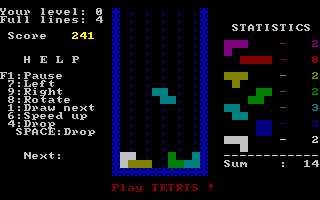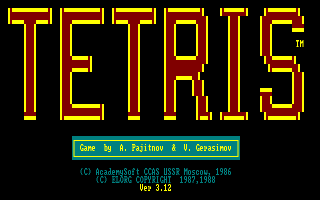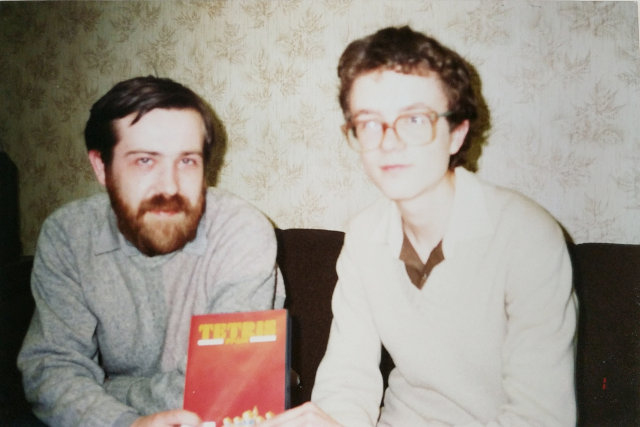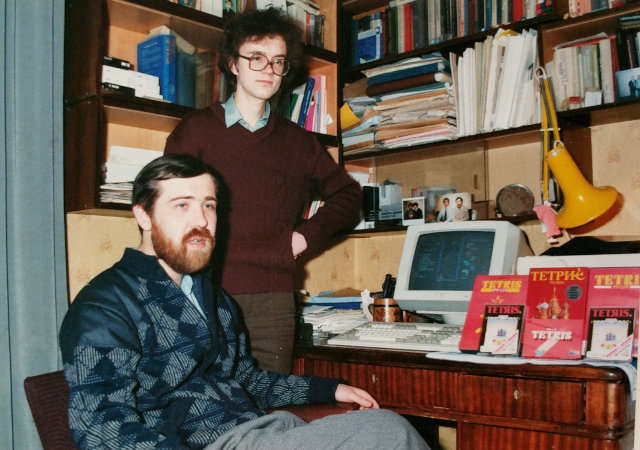Tetris Story Links
Tetris Documentary
Original Tetris Download
Antix Download
Tetris on the Green Building
Pushed past the brink
Tetris Story
Tetris is a popular game developed in 1984-86 by Alexey Pajitnov (Pazhitnov), Dmitry Pavlovsky, and me. Pajitnov and Pavlovsky were computer engineers at the Computer Center of the Russian Academy of Sciences. I was a 16-year-old high school student. My computer science teacher Arkady Borkovsky brought me to the Computer Center where I worked and played with IBM PCs. I quickly learned programming and enjoyed working on various fun computer projects.
Dmitry noticed me when I was writing a directory encryption program for MS DOS. He told me that he liked computer games and had designed a few games for a mainframe computer. He asked me if I was interested in helping him to convert the games to the PC and to work together on new game ideas. I was obviously very interested. Pavlovsky showed me his games and gave me the source code of one of them. On the next day I made a PC version of his game. We started working together.
Very soon Dmitry introduced me to his friend Alexey Pajitnov who was also interested in making computer games. Dmitry told me that Alexey had even managed to sell some of his psychology-related games. Alexey showed us a couple of games he developed earlier. We decided to work as a team. My roles were a PC expert, programmer, and graphics designer.
Our plan was to make about a dozen addictive computer games for the PC and put them together in one system we called a computer funfair. Pajitnov and Pavlovsky also thought about selling the games. The selling part seemed unusual and difficult because we lived in the Soviet Union. Making and selling something privately was highly irregular. We focused on making development tools for the PC, converting earlier games to the PC, and developing new game ideas.
In a few weeks we had converted most of the worthy older games and developed a good set of libraries to support graphics (4-color 320x200), text, and sound in our games. We gathered quite often to discuss new ideas, and to code the games. In a few months we had a nice set of games. Most of those games are probably lost. I recently found only one of them. The game was a remake of Xonix with an inverted hidden play field. Dmitry named it Antix (short for Antixonix). Warning: the game does not have a proper timer delay and runs too fast on modern computers unless you use some emulation software. I do not know who developed the original Xonix. But the game was a smashing success at the Computer Center and elsewhere around Moscow before Tetris spread around.
A few months after we started working together, Pajitnov came up with the Tetris idea. Before we met he had a computer game called Genetic Engineering. In that game the player had to move the 4-square pieces (tetramino) around the screen using cursor keys. The player could assemble various shapes. I don't remember the exact objective of that game, but it seemed rather dull.
At one of our meetings Pajitnov told Pavlovsky and me about his new idea of tetramino falling into a rectangular glass and piling up at the bottom. He believed the game might be successful. Shortly after discussing the idea Pajitnov made a prototype for Electronica 60, then I ported it to the PC using our development system. Pajitnov and I kept adding features to the program for a couple of years.
The game name "Tetris" was purely Alexey's idea. The word is a combination of "tetramino" and "tennis". I thought it sounded a bit strange in Russian, but Pajitnov insisted on giving the game this name.
A couple of years later Pajitnov and I also developed a 2-player version of Tetris and worked on a couple of psychological test projects for Alexey's friend Vladimir Pokhilko. Vladimir was the first clinical psychologist who conducted experiments with Tetris. In the 2-player Tetris the glass had no bottom. The pieces for the first player move from the top, for the second - from the bottom. Two players competed for the space inside.
Pajitnov's efforts to sell the games together failed. We decided to give our friends free copies of the games including Tetris. The games quickly spread around. When the freely distributed PC version of Tetris got outside of the Soviet Union and a foreign company expressed an interest in licensing Tetris, Pajitnov decided to abandon all the games but Tetris. The decision made Pavlovsky very unhappy and destroyed our team.
In 1991 Pajitnov moved to the USA with his friend Vladimir Pokhilko. Pavlovsky immigrated to UK in 1990.
Tetris has generated a lot of revenue for sometimes unexpected organizations and people and caused a few nasty legal clashes. You can read about the business side of the story in the book Game Over by David Sheff. An interesting BBC documentary filmed in 2003-2004 portrays some of the events and presents views of a few key people involved in the business turmoil.
Alexey Pajitnov and an American entrepreneur Henk Rogers founded the Tetris Company. I have nothing to do with the company, and do not support its policy. Contrary to the claim attributed to Henk Rogers there were no "straightforward business arrangement" between Pajitnov and myself. In the Soviet Union, where private business was outlawed and the concept of intellectual property was not defined, people could not make private business arrangements of this kind. The Computer Center of Academy of Sciences owned everything we made. Several years later the situation in the Soviet Union changed, but this was a different story. When I worked on Tetris, even a government organization could not formally hire me because I was underage. I worked on Tetris just for fun. I don't remember Pajitnov ever paying me for anything related to Tetris either. Pajitnov started fixing the business aspects of the situation a few years later when he and Henk Rogers participated in negotiations with Elorg (the only government organization in the USSR that could sell software abroad). Pajitnov stopped by my home and asked me to urgently sign a paper "to get lots of money for us from game companies". He didn't leave me a copy of the paper. As far as I remember the paper was saying that I agree to only claim porting Tetris to the PC, agree to give Pajitnov the right to handle all business arrangements, and refuse any rewards related to Tetris. I did not entirely agree with the content, but I trusted Alexey and signed the paper anyway. In a few months my name disappeared from all newly released versions of Tetris and all Tetris-related documents. Alexey registered a US copyright (R/N PA-412-170) referencing the free PC version of Tetris (original version 3.12) we developed together.

The first MS DOS version of Tetris was implemented a few days after Alexey put together his first prototype of the game for the Electronica 60. All three of us - Dmitry, Alexey, and I - were fans of Pascal and structured programming despite then-recently-published text "Real Programmers Don't Use Pascal". We used various flavors of Pascal to implement our game ideas. Under MS DOS the development system of choice was Borland's Turbo Pascal. I started learning programming with v1.0. In fact, I still enjoy programming in the descendant of Turbo Pascal - Borland Delphi. The last version of Tetris, we worked on together, was compiled with Turbo Pascal 4. That last version of the game had number 3.12. Although 3.12 is pretty much an arbitrary number as we did not have a strict versioning policy. By the way, this version has an Easter Egg. Although not a sophisticated one. I wonder if anyone can discover it.
The MS DOS version is quite different from the Electronica 60 draft which initially had just the glass and a score count. That version worked on a monochromatic (green/black) alphanumeric display. The tetramino squares were drawn as a pair of square brackets [ ]. Remarkably, the game was playable and addictive even in that form. This gave us a reason to hurry up with the MS DOS implementation. I believe Alexey expanded his Electronica version of the game after we ported it to the PC to match some of the features we had in our PC games. I never worked with Electronica computers myself.
We diligently implemented the MS DOS version of the game in such a way that it could run on any PC we had available. The program ran in a text mode using colored space symbols to represent squares of teraminos. The game could even automatically recognize the IBM monochrome card adjusting the way it drew (printed) on the screen. The clock-frequency race had already started with the introduction of IBM PC AT and PC clones. Many games released for the earlier PC and PC XT (4.77 MHz) models ran too fast on the newer machines. The last version of our game was one of the first to use proper timer delays. 20 years later the same program still runs without any changes, looks and feels the same (especially in the full screen DOS box).


